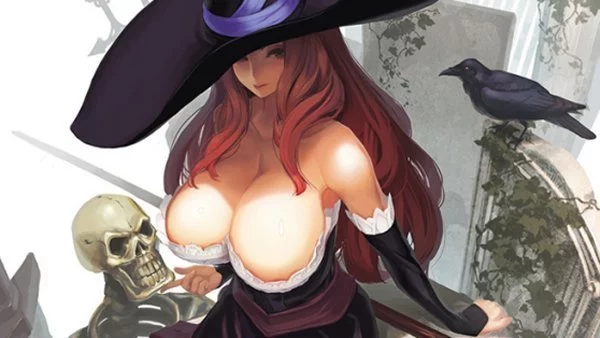Atlus — both as developer and publisher — has always been a constant source of charming and slightly left-of-centre Japanese titles, including Shin Megami Tensei, Snowboard Kids, Trauma Centre and, of course, the wonderful Persona series. Dragon’s Crown, developed by Japanese developer Vanillaware (itself consisting of individuals who worked in the original Atlus development team) is no exception, but it is somewhat disappointing to note that some… interesting design choices detract from the game itself. But we’ll get to that.
Dragon’s Crown is, essentially, a reimagining and reinventing of the side-scrolling hack-‘n’-slash genre. The President of Vanillaware, George Kamitani was actually involved in the development of some of my favourite arcade brawlers, Capcom’s Dungeons & Dragons series (see my review of the recent re-release here), and his influence shows.
Playing as an RPG/hack-‘n’-slash hybrid, Dragon’s Crown puts you in the role of one of six warriors, each unique in their capabilities, competencies and constituency. Some, like the fighter, are built in such a way as to make the game somewhat easier to play, while others, including the Witch and Wizard, require a more ranged and strategic form of play, and as such are a more challenging experience. In this way, while there is no difficulty selection available at the start (a hard mode is unlocked later in the game), character choice informs the gameplay, both in terms of mechanics and difficulty. With local and online multiplayer for up to four players (replaced by the AI in single-player mode), there’s lots of fun to be had.
Essentially a 2D scroller, Dragon’s Crown puts the player in fictitious Hydeland, providing access within the main hub to various shops and contacts over the course of the game, giving access to special items, support, additional quests, and so on. From this hub, a town gate transports the player to one of 9 locations, each to be revisited time and time again, depending on the quest. Each has secret rooms to search, and later in the game, a branching path to take, but with so few locations versus so many quests, things get a little repetitive after a while.
Progressing through levels and completing quests will reward the player with gold and loot; the former can be used to buy goods and services (of course), while the latter can be used to upgrade your character. Certain items are role-specific, some require higher levels, and other, more rare items, are found by what seems to be pure luck – loot drop appears to be random. While nothing ground-breaking, this form of role playing is tried and tested, and in this case is extremely satisfying.
Part of this satisfaction comes down to the little things – changing a weapon or shield is reflected on your character, and the weapon/shield designs themselves are marvelous. Oftentimes (in similar titles), changing a weapon FEELS different, but LOOKS the same; this is not the case in Dragon’s Crown, and it’s a welcome addition. Further, each new upgrade or ability results in a tangible change to the feel of your character, and this drives the desire to progress. Plus, some of the weapons/shields are just nice to look at.
In fact, everything looks fantastic in Dragon’s Crown. From the character models, to the backgrounds, to the many various enemies (the variety is superb), the hand-painted artwork is jawdropping. Screenshots don’t do the game justice – you need to see it in action to appreciate the complexity of both the artwork and the animation. Gorgeous.
Story-wise, I’m divided. In some ways, it’s standard fare – it can be diluted down to one big fetch quest. In other ways, there are things that happen in the narrative that raised the eyebrows from time to time; however, I found that much of the to-ing and fro-ing within the town was superfluous. In fact, for a brawler, there was decidedly too much ‘not brawling’ (trademark) for my liking. I can see what Vanillaware was trying to achieve; the repetitive pre-questing provides an anchor to strengthen the role playing (to some extent), but it was fairly unnecessary for the kind of title that it is.
Still – in terms of gameplay, it’s extremely satisfying … even given that it is repetitive and you go back to the same environments over and over, it just plays so damned well along the way. The moveset differs from character to character, different weapons will change your play style, certain enemies require specific tactics, and the bosses are HARD. If this is the kind of game you like – it’s so much better with a bit of Diablo-style looting thrown in.
Dragon’s Crown is available for PS3 and PS Vita, but unfortunately, is not a part of the Cross Buy program (this means if you want it on both machines, you need to buy it on both machines). It does use the Cross Save feature, though, and if this is the kind of game that peels your banana, then it might be worth grabbing both. I played on Vita, and while it looked gorgeous and played extremely well, there was significant slowdown when things got hectic. Dealbreaker? No. But it’s noticeable and has an impact on the game.
There are some strange choices, control-wise; the right thumbstick, for example, controls a pointer much like a mouse. Primarily used to direct your support to unlock chests and doors, it was annoying at first, but soon found its way in to my routine. It can also be used to uncover additional loot while you play, or to poke and prod the often provocative artwork in cutscenes…
Which leads me to the most… controversial… point. Character design in Dragon’s Crown is exceptionally exaggerated; the Dwarf has pecs that never sleep, the Fighter is a walking torso, and the Witch? Well… she’s also top-heavy. While it can certainly be argued that this exaggeration extends to all playable characters, and all primary NPCs, the reality is that the female form is hyper-sexualised. Is this an issue? Well, not necessarily – the game is unapologetically titillating in much the same way as some movies are from time-to-time, and there is a place for that. My problem is not so much that the characters are (ahem) larger than life, but instead that, once again, many supporting female characters are made out to be the “damsel in distress”, often wearing a see-through silky sheet for a dress: one that leaves little to the imagination. One cut scene that has been hotly debated shows a female monk laying prone and injured, her legs pulsing and spreading for the camera, begging for your help…
Of course, the most sexualised characters are not just a pretty face. The playable characters are all insanely strong, both in terms of power and capability, and it makes it hard to argue that this is anything more than an adolescent design scheme, and there’s nothing wrong with that…
The reality is, though, this is only an issue at face value. There is so much more to Dragon’s Crown than breasts and thighs, and it wasn’t far into the game that I stopped paying attention. In fact, there is so much to like about Dragon’s Crown that I wrestled with ignoring that topic completely, but that would be disingenuous.
Dragon’s Crown, for all its extravagance and its controversy, is a hell of a great fun beat-’em-up/hack-‘n’-slash/RPG/whatever. It’s a bit repetitive, and the storyline works to derail the game itself, but put all of that to the side and it’s a fun romp through fantastical territory.
This article may contain affiliate links, meaning we could earn a small commission if you click-through and make a purchase. Stevivor is an independent outlet and our journalism is in no way influenced by any advertiser or commercial initiative.
























